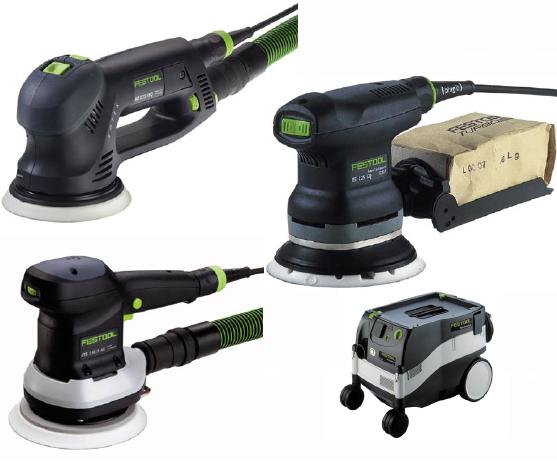

Three of a Kind
Festool's Rotex RO125, ETS 150
and
Random Orbit Sanders
by
14 Apr 2006
StickFix Pad
Festool calls their hook and loop attachment system StickFix. The ETS 150 has a 6" sanding pad which is easily removable with one hex screw and the included hex wrench (right). The StickFix system uses 9 hole sanding disks with the center hole actually blowing air out with the 8 holes around the circumference of the disk drawing air and dust in. Festool claims that this arrangement keeps the disk cleaner therefore making it more effective and extending its life by 30%. I can tell you that after using these sanders for quite some time that that figure seems low for the Rubin paper. But more on that later in the testing section.
The ETS 150 also has a pad brake, you can see it in the photo at left as the rubber ring which surrounds the pad.
The ES 125 is a 5" Random Orbit one handed or
palm grip sander with a 2.5mm (3/32) stroke. It weighs about 2.5lbs or
just over half the 4lb weight of the ETS 150 which makes it ideal for one
handed, vertical or overhead sanding. Like the ETS 150 it comes with a
dust bag (pictured at left) but should really be used with a vacuum.
Specifications: ES 125
Power consumption: 220 Watts / 2 amps 120 v Ac
Pad diameter: 5" (125 mm)
Speed: 6000 - 13000 orbits per minute
Sanding stroke: 3/32" (2.5 mm)
Dust extractor connection: 1" (27 mm)
Weight: 2.4 lbs. (1.1 kg)
Controls:
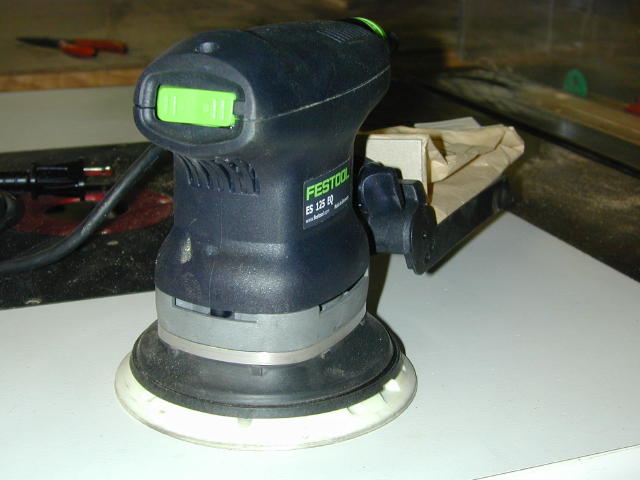
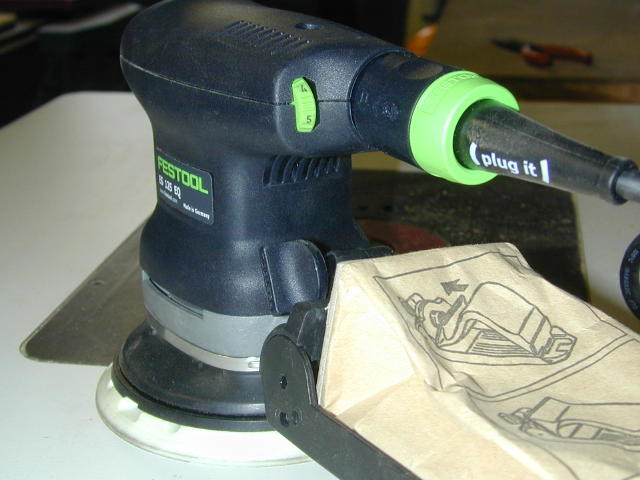
Control layout is a bit different for this sander because it doesn't have a handle like its big brother. Powering the ES 125 is accomplished by an on/off toggle switch located at the front top of the sander (left) and speed by a thumbwheel located at the top rear of the sander (right). The ES 125 also has the Plug-It removable cord feature.
 The
ES 125 also has a 9 hole StickFix pad and is attached by 4 Torx head screws.
Like the ETS 150 the pad must be removed to gain access to the brake although a
tool in not included.
The
ES 125 also has a 9 hole StickFix pad and is attached by 4 Torx head screws.
Like the ETS 150 the pad must be removed to gain access to the brake although a
tool in not included.
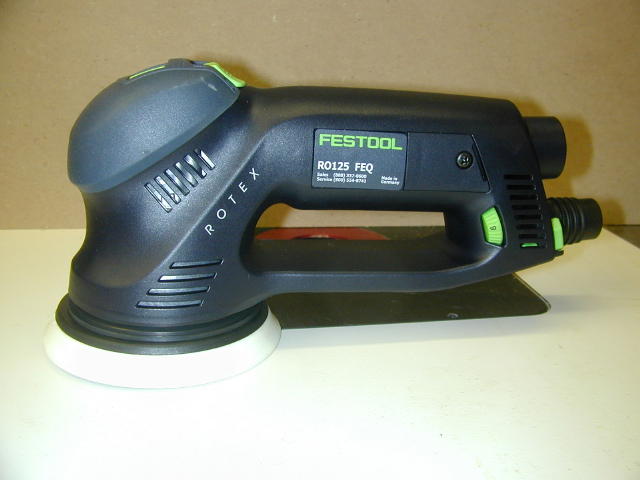 The Rotex RO 125 is a departure
from the conventional sanders because it is actually two sanders in one.
This dual mode sander fulfils all your fine random orbit sanding needs with its
5" diameter, 3.6mm (9/64") stroke and with the press of a button turns into an
aggressive yet very controllable rotary sander. Perhaps one reason it is
so controllable and aggressive in the rotary mode is because the pad performs a
random orbit while it is rotating, an operation that I believe is unique to the
Rotex.. With accessories you can
also use this sander in a third mode, that of a polisher. At 4.4lbs the Rotex is light enough for extended use and its ergonomic design feels right at
home in your hands.
The Rotex RO 125 is a departure
from the conventional sanders because it is actually two sanders in one.
This dual mode sander fulfils all your fine random orbit sanding needs with its
5" diameter, 3.6mm (9/64") stroke and with the press of a button turns into an
aggressive yet very controllable rotary sander. Perhaps one reason it is
so controllable and aggressive in the rotary mode is because the pad performs a
random orbit while it is rotating, an operation that I believe is unique to the
Rotex.. With accessories you can
also use this sander in a third mode, that of a polisher. At 4.4lbs the Rotex is light enough for extended use and its ergonomic design feels right at
home in your hands.
Specifications: RO 125
Power consumption: 500 Watts / 4.2 amps 120 v AC
Pad diameter: 5" (125 mm)
Speed rotary motion: 300 - 600 rpm
Speed eccentric motion: 3000 - 6000 rpm
Sanding stroke: 9/64" (3.6 mm)
Dust extractor connection: 1" (27 mm)
Weight: 4.4 lbs. (2 kg)
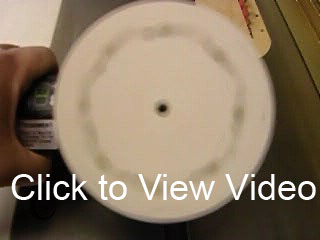 This
short video demonstrates how the rotary and random
actions are combined. The Rotex is set on the slowest speed so you can see
it. Watch the outer holes and disc edge "blur" from the RO movement.
This
short video demonstrates how the rotary and random
actions are combined. The Rotex is set on the slowest speed so you can see
it. Watch the outer holes and disc edge "blur" from the RO movement.
Controls:
There are four buttons on the Rotex. At left, my thumb is on the power on/off switch...push on/push off. Above the on/off switch is a slider which changes from Random Orbit to Rotary mode. At right is the speed thumbwheel similar to the other sanders. And the button by the vacuum port is the pad lock which enables the tool-less pad change. Also, like the others, the Rotex has the removable Plug-It power cord. Because of the rate at which the Rotex removes material a dust bag would fill up in no time and therefore was not included in the design. To collect sanding dust the Rotex must be connected to a vacuum.
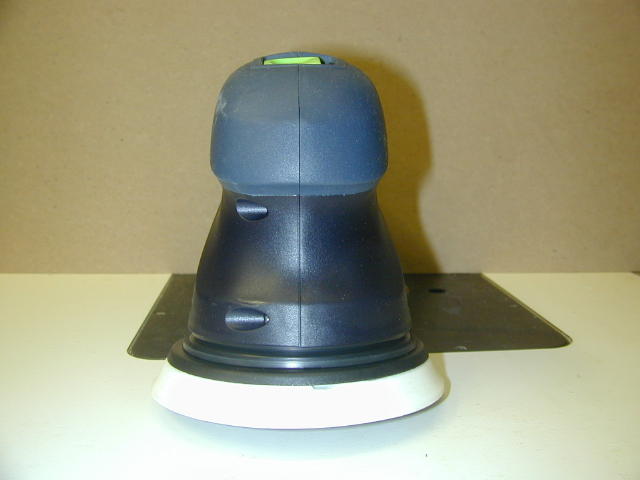
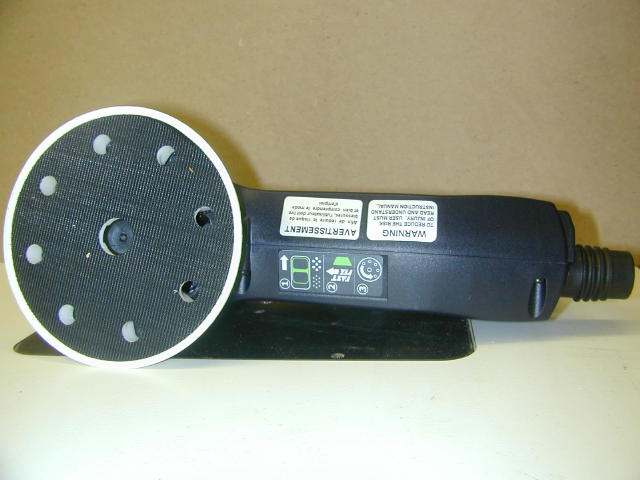 The
Rotex does have a soft grip (left) and a 5", 9 hole StickFix pad (right) which is
removable without tools. Since the Rotex has a variety of accessory pads,
soft, hard and polishing the tool-less removal is a plus.
The
Rotex does have a soft grip (left) and a 5", 9 hole StickFix pad (right) which is
removable without tools. Since the Rotex has a variety of accessory pads,
soft, hard and polishing the tool-less removal is a plus.
To remove the pad put the Rotex into the rotary mode, depress the pad shaft lock and rotate the pad counterclockwise (left).
The pad is removed (right).
Sander maintenance:
About the only maintenance you'll have to perform other than cleaning is replacing the sanding pad if it gets worn and replacing the brake when it wears. The brake is a wear item and will need replacing about every 100 hours or so. The following will help guide you through the brake replacement...it is quite simple.
The photo at left shows the Rotex pad removed
using the technique I explained above, and the brake removed. The brake is
simply attached by tabs in slots and to remove the old one you just grab it and
pull it off. To replace the brake you just align the tabs and insert them
into the slots as shown in the photo at right. That's it. Now
replace the pad and you're ready to go.
When the brake is properly seated, it will look like the photo at left while an improperly installed brake will look like the photo at right.
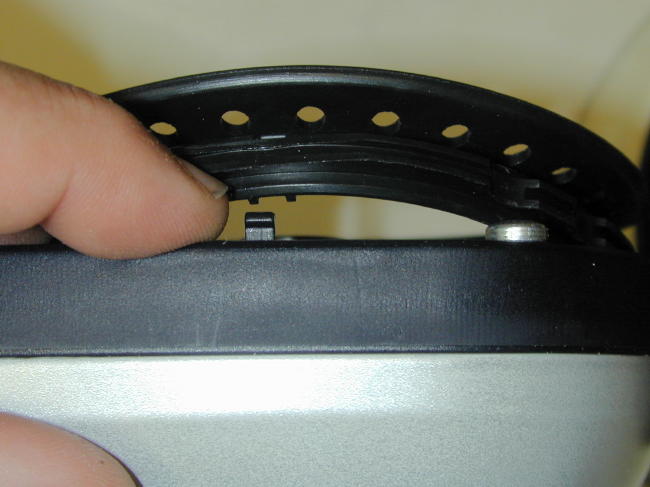
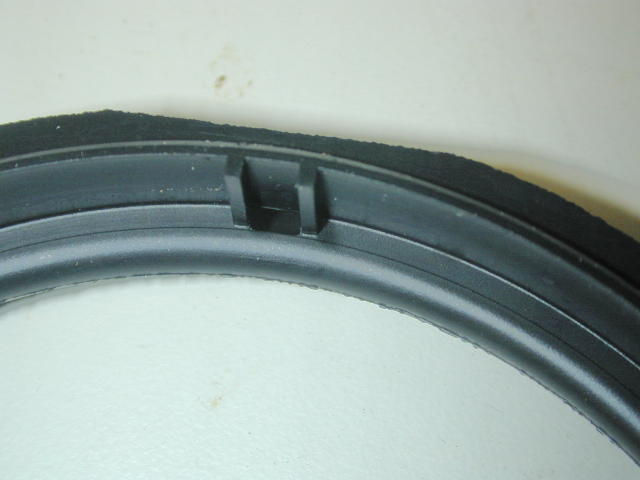 The
ETS 150 is a bit different. The tabs are not on the brake like the Rotex
but on the sander itself (left). At right is a picture of the brake and
the recess into which the sander tabs must be inserted.
The
ETS 150 is a bit different. The tabs are not on the brake like the Rotex
but on the sander itself (left). At right is a picture of the brake and
the recess into which the sander tabs must be inserted.
When you push the brake on over the tabs, there are also some screws which have to fit between small tabs on the outer diameter of the brake.
Just make sure everything sits flush and you're all set.
The ES 125 is different in that the brake is attached by a crimped metal band. The replacement for this brake comes with a screw adjustable band.
[Page 1][Page 2] [Page 3] [Next]